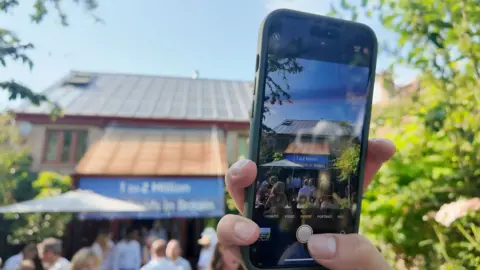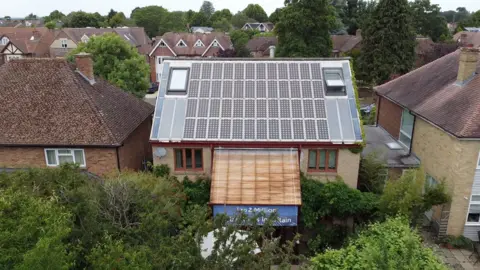The roof that led a revolution in domestic energy
 BBC
BBCThirty years ago, a quiet suburban street barely noticed the start of a revolution being built on its doorstep.
A house constructed in 1995 was the first in Britain to incorporate a solar roof and would set the agenda for domestic renewable energy.
Earlier this month, Energy Secretary Ed Miliband said the "vast majority" of new build homes in England will be required to have solar panels.
Key pioneers and figures from Britain's solar energy community have gathered to mark the 30th anniversary of the Oxford Ecohouse that led the way.

Leading the way doesn't come cheap.
The first ever solar roof cost Prof Sue Roaf £28,000 to build. With no planning regulations at the time that addressed such a construction, the build proved particularly challenging.
She told the BBC: "To build this house, I had so much help from the industry because they bought into the vision.
"The idea that with the ordinary family home you could have a decent, ordinary life and have very little footprint on the planet."
Despite the challenges the build was a success. The six-bedroom home produces 130kg CO2 a year per sqm. A comparable UK house produces 5,000kg CO2 a year per sqm.
"We were seen as living the ordinary life but just slightly differently," she said. "It was the solar life."

The award-winning house gained international attention and inspired a new wave of climate architects.
"Sue was this slightly legendary figure," recalls architect and TV presenter Charlie Luxton, who was studying at the time.
The house brought photovoltaics (PV) - the process of converting light into electricity using semiconducting materials - and "low energy architecture to a very domestic setting", he said.
"The house could fit in on any street. I think that's what is so amazing about this project - that it could be everywhere, it should be everywhere.
"Every house built since then should have looked like this or at least had this level of thinking around PV and low energy and reducing the impact on planet and climate."

Despite the revolutionary house being built in 1995 the idea of solar on domestic properties took a while to catch on.
"It wasn't until 2010 that the panels really became affordable," said Prof Roaf.
Fast forward to 2025 and Energy Secretary Ed Miliband has said builders will be required to fit solar panels to the "vast majority" of new homes in England under changes to be published this year.
The rules will be included in the Future Homes Standard, which will detail a wider plan for improving energy efficiency and reducing carbon emissions.
With a government target of 1.5 million new homes to be built by 2029, insisting new homes have solar panels could make a significant contribution.
But architects like Alex Michaelis are worried such policies will not be permanent.
He said: "The fear always with these things is that in five years' time, with a change in government, they scrap it.
"This is one of my big things, that a lot of these things should not be party-politically based but there should be another body that says 'right, we set this in stone for 20 years'."

One lasting legacy of the Ecohouse was the effect it would have on one of Prof Roaf's sons.
Richard Roaf appeared as a schoolboy on Blue Peter when the programme featured the home.
He gained the nickname "solar panel boy" but says that didn't put him off.
"I think my mum predicted it a bit before a few other people but I was actually inspired to get really involved in climate change campaigning," he said.
"I think both the solar house and being on Blue Peter, despite the nickname, did inspire me to go off in that direction."
Standing on the balcony of the home she built, Prof Roaf reflected on what has been achieved as guests gathered for the anniversary party.
"I'm proud of what we built together because it wasn't me who bought the house, it was the team," she said. "And lots of them have come to celebrate."
As for the running costs for the house?
"Last month, for gas and electric without VAT and without standing charges, it was £7.56. I rest my case, your honour."
You can follow BBC Oxfordshire on Facebook, X (Twitter), or Instagram.
